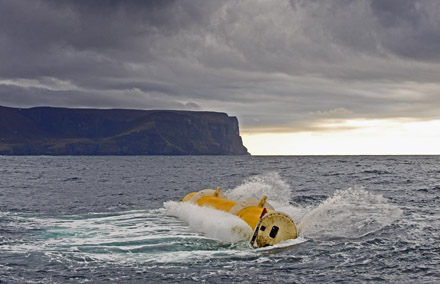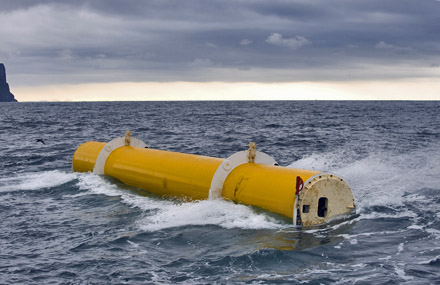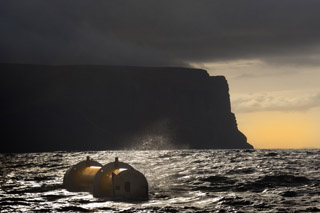Navigation
Nearshore Waves Ideal For Wave Energy Says New Scientist
Nearshore waves offer much better prospects for wave energy development than previously thought, according to a report published in this week’s New Scientist magazine, 8 May 2010.
 |
| Oyster in Operation Photograph by Aquamarine Power |
Nearshore waves offer much better prospects for wave energy development than previously thought, according to a report published in this week’s New Scientist magazine, 8 May 2010. The article quotes scientist Dr Matt Folley of Queen’s University, Belfast, who has calculated how much energy can be extracted from all wave types. He has found that nearshore waves offer almost as much exploitable energy as offshore waves.
 |
| Oyster in Operation Photograph by Aquamarine Power |
Folley’s research, the New Scientist says, shows that nearshore waves 0.5 to 2 kilometres from the coast carry 80 to 90 per cent of the usable energy of waves further out. He calculates that offshore waves carry exploitable power at a density of around 18.5 kilowatts per metre-slice, compared with about 16.5 kilowatts for nearshore ones.
Standard figures have historically overestimated the utility of offshore waves for two reasons, Folley tells the New Scientist. They allowed severe storms to push up the average power figures, says Folley; however in reality wave power devices generate little power in such storms because they may have to switch into a self-preservation mode.
Previous figures also assumed that offshore waves have a prevailing direction, Folley goes on to say in the article, in the same way that nearshore waves tend to move towards the coast. However it is now understood that offshore waves come from a greater range of directions meaning that some harvesters in an offshore wave farm would be blocked by others. Nearshore farms could be strung out in lines to avoid that, says Folley.
 |
| Oyster in the Evening Photograph by Aquamarine Power |
Folley’s findings, which have been published in two peer-reviewed papers, are backed up in the New Scientist report by leading wave energy academic Professor Ian Bryden of University of Edinburgh who finds the figures “convincing”.
The findings are good news for wave energy developer Aquamarine Power whose Oyster technology is designed specifically to harness the energy found in nearshore waves. The company has identified 8GW of exploitable nearshore energy in UK and Irish waters – enough energy to power around seven million homes.
Read the full New Scientist report here.
This article is from Aquamarine Power, 10 May 2010.
All photographs are courtesy of Aquamarine Power.
Notes:
Videos are available at www.youtube.com/
Other articles about Aquamarine Power's Oyster are available at:£5.1M Government Funding Secured To Develop Wave Energy Device, Oyster 2
and
Hydro-electric Wave Energy Device “Oyster” Launched Off the Coast of Scotland
Search
Latest articles
Agriculture
- World Water Week: Healthy ecosystems essential to human health: from coronavirus to malnutrition Online session Wednesday 24 August 17:00-18:20
- World Water Week: Healthy ecosystems essential to human health: from coronavirus to malnutrition Online session Wednesday 24 August 17:00-18:20
Air Pollution
- "Water and Sanitation-Related Diseases and the Changing Environment: Challenges, Interventions, and Preventive Measures" Volume 2 Is Now Available
- Global Innovation Exchange Co-Created by Horizon International, USAID, Bill and Melinda Gates Foundation and Others
Biodiversity
- It is time for international mobilization against climate change
- World Water Week: Healthy ecosystems essential to human health: from coronavirus to malnutrition Online session Wednesday 24 August 17:00-18:20
Desertification
- World Water Week: Healthy ecosystems essential to human health: from coronavirus to malnutrition Online session Wednesday 24 August 17:00-18:20
- UN Food Systems Summit Receives Over 1,200 Ideas to Help Meet Sustainable Development Goals
Endangered Species
- Mangrove Action Project Collaborates to Restore and Preserve Mangrove Ecosystems
- Coral Research in Palau offers a “Glimmer of Hope”
Energy
- Global Innovation Exchange Co-Created by Horizon International, USAID, Bill and Melinda Gates Foundation and Others
- Wildlife Preservation in Southeast Nova Scotia
Exhibits
- Global Innovation Exchange Co-Created by Horizon International, USAID, Bill and Melinda Gates Foundation and Others
- Coral Reefs
Forests
- NASA Satellites Reveal Major Shifts in Global Freshwater Updated June 2020
- Global Innovation Exchange Co-Created by Horizon International, USAID, Bill and Melinda Gates Foundation and Others
Global Climate Change
- It is time for international mobilization against climate change
- It is time for international mobilization against climate change
Global Health
- World Water Week: Healthy ecosystems essential to human health: from coronavirus to malnutrition Online session Wednesday 24 August 17:00-18:20
- More than 400 schoolgirls, family and teachers rescued from Afghanistan by small coalition
Industry
- "Water and Sanitation-Related Diseases and the Changing Environment: Challenges, Interventions, and Preventive Measures" Volume 2 Is Now Available
- Global Innovation Exchange Co-Created by Horizon International, USAID, Bill and Melinda Gates Foundation and Others
Natural Disaster Relief
- STOP ATTACKS ON HEALTH CARE IN UKRAINE
- Global Innovation Exchange Co-Created by Horizon International, USAID, Bill and Melinda Gates Foundation and Others
News and Special Reports
- World Water Week: Healthy ecosystems essential to human health: from coronavirus to malnutrition Online session Wednesday 24 August 17:00-18:20
- STOP ATTACKS ON HEALTH CARE IN UKRAINE
Oceans, Coral Reefs
- World Water Week: Healthy ecosystems essential to human health: from coronavirus to malnutrition Online session Wednesday 24 August 17:00-18:20
- Mangrove Action Project Collaborates to Restore and Preserve Mangrove Ecosystems
Pollution
- Zakaria Ouedraogo of Burkina Faso Produces Film “Nzoue Fiyen: Water Not Drinkable”
- "Water and Sanitation-Related Diseases and the Changing Environment: Challenges, Interventions, and Preventive Measures" Volume 2 Is Now Available
Population
- "Water and Sanitation-Related Diseases and the Changing Environment: Challenges, Interventions, and Preventive Measures" Volume 2 Is Now Available
- "Water and Sanitation-Related Diseases and the Changing Environment: Challenges, Interventions, and Preventive Measures" Volume 2 Is Now Available
Public Health
- Honouring the visionary behind India’s sanitation revolution
- Honouring the visionary behind India’s sanitation revolution
Rivers
- World Water Week: Healthy ecosystems essential to human health: from coronavirus to malnutrition Online session Wednesday 24 August 17:00-18:20
- Mangrove Action Project Collaborates to Restore and Preserve Mangrove Ecosystems
Sanitation
- Honouring the visionary behind India’s sanitation revolution
- Honouring the visionary behind India’s sanitation revolution
Toxic Chemicals
- "Water and Sanitation-Related Diseases and the Changing Environment: Challenges, Interventions, and Preventive Measures" Volume 2 Is Now Available
- Actions to Prevent Polluted Drinking Water in the United States
Transportation
- "Water and Sanitation-Related Diseases and the Changing Environment: Challenges, Interventions, and Preventive Measures" Volume 2 Is Now Available
- Urbanization Provides Opportunities for Transition to a Green Economy, Says New Report
Waste Management
- Honouring the visionary behind India’s sanitation revolution
- Honouring the visionary behind India’s sanitation revolution
Water
- Honouring the visionary behind India’s sanitation revolution
- Honouring the visionary behind India’s sanitation revolution
Water and Sanitation
- Honouring the visionary behind India’s sanitation revolution
- Honouring the visionary behind India’s sanitation revolution

